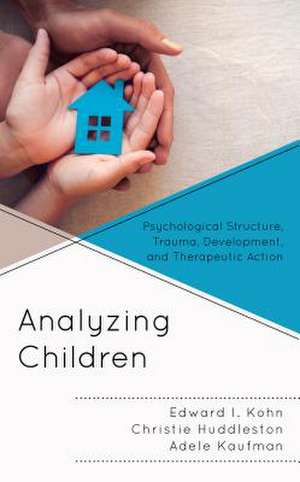ANALYZING CHILDREN PSYCHOLOGICB: The Vulnerable Child Series
Autor Adele Kaufmanen Limba Engleză Hardback – 4 iun 2019
Preț: 484.19 lei
Preț vechi: 616.81 lei
-22% Nou
Puncte Express: 726
Preț estimativ în valută:
92.65€ • 96.74$ • 76.51£
92.65€ • 96.74$ • 76.51£
Carte indisponibilă temporar
Doresc să fiu notificat când acest titlu va fi disponibil:
Se trimite...
Preluare comenzi: 021 569.72.76
Specificații
ISBN-13: 9781538121023
ISBN-10: 1538121026
Pagini: 250
Dimensiuni: 152 x 229 x 22 mm
Greutate: 0.49 kg
Editura: Rowman & Littlefield
Seria The Vulnerable Child Series
ISBN-10: 1538121026
Pagini: 250
Dimensiuni: 152 x 229 x 22 mm
Greutate: 0.49 kg
Editura: Rowman & Littlefield
Seria The Vulnerable Child Series
Notă biografică
Edward I. Kohn, M.D. is on the faculty of the Cincinnati Psychoanalytic Institute and the Southeast Consortium for Child and Adolescent Psychoanalysis, serving as a training and supervising analyst at CPI and a child and adolescent supervising analyst at both CPI and the Southeast Consortium.
Christie Huddleston, M.D. is a psychiatrist and psychoanalyst in private practice in Philadelphia. She is on the faculty of the Psychoanalytic Center of Philadelphia and director of the Adult Psychoanalytic Program. She teaches and supervises psychiatric residents at the Hospital of the University of Pennsylvania and Einstein Medical Center.
Adele Kaufman, MSW is Training and Supervising Analyst, and Child and Adolescent Supervising Analyst at the Chicago Institute for Psychoanalysis. She received the Chicago Institute's 1988 Michael Littner Distinguished Scholar Award and was co-chair of the Child and Adolescent Committee during 2006-2010; she has recently been co-Dean of the Chicago Institute. She is in the private practice of child, adolescent, and adult psychoanalysis in Highland Park, Illinois.
Descriere
The book describes theoretical models of the mind, and how they apply to the two cases, exploring how to make diagnostic distinctions early enough to plan treatment more coherently, and to avoid unexpected negative reactions. It facilitates discussion between theoretical "camps" and offers ways of deepening the clinical understanding of patients.

